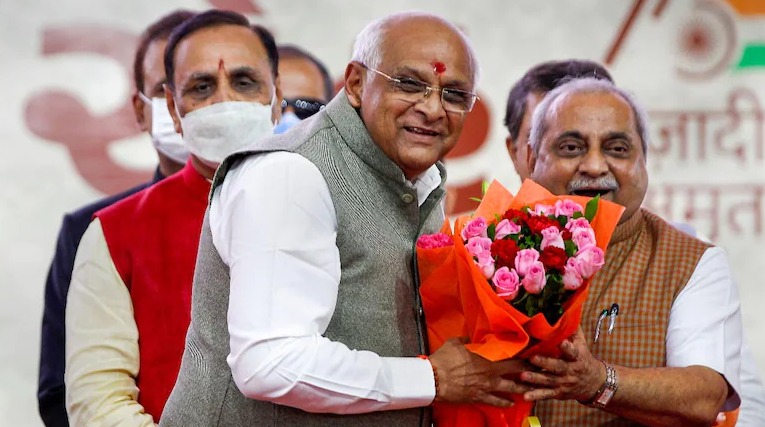Springing surprises has become a stock-in-trade for the BJP under the stewardship of Prime Minister Narendra Modi and Union Home Minister Amit Shah. Starting from the dramatic and disastrous demonetization, the style of functioning of the two tallest leaders of the saffron brigade has now left its imprint once again on the surprise selection of the Gujarat Chief Minister, Bhupendra Patel who earns the rare distinction of being catapulted to the top slot after becoming an MLA for the first time in his rather obscure political career. If taking the Opposition off guard had propelled Modi-Shah combine to resort to making surprise decisions on major issues, injecting the element of surprise into the shuffling of Chief Ministers in BJP-ruled states has more compelling reasons and is turning out to be a dire political necessity. It is no coincidence that the new Gujarat Chief Minister becomes the fifth new face in the past six months to head the party’s state governments. Before the ousted Gujarat CM Vijay Rupani, the BJP had shown the door to four other Chief Ministers – BS Yediyurappa in Karnataka, Sarbananda Sonowal in Assam and the double exit in Uttarakhand of Tirath Singh Rawat and Trivendra Rawat.
Tirath Singh Rawat resigned as Uttarakhand’s Chief Minister July 3, less than six months after taking oath March 10. He had replaced Trivendra Singh Rawat. But, he was replaced by Pushkar Singh Dhami July 4. Then it was the turn of Yediurappa who resigned July 26 after weeks of uncertainty. The choice of Patel is the most surprising of the lot since Rupani had to resign after ruling the state for nearly four years and just 15 months before Gujarat goes to Assembly polls in December 2022.
Normally, political parties punish their non-performing or corrupt MPs and MLAs by denying them tickets in the next polls. But, removing incumbent CMs in such quick succession to save the government from being dislodged through people’s mandate is a new trend. The BJP top leadership is seemingly trying to send out a message. It will rather accept the Opposition’s ridicule than risk the government in the next term. The trend started since the party’s defeat in the Jharkhand election six months after the BJP won a massive victory in the Lok Sabha in 2019. It lost the election in Jharkhand to the alliance led by Hemant Soren. This was on the cards considering the extreme unpopularity of the then BJP Chief Minister Raghubar Das. Local leaders lobbied for the removal of Das, but the warning was not heeded and the party lost. The defeat in Jharkhand and the survival of the Haryana BJP government by a wafer thin majority achieved through a coalition must have taught the top party brass the lesson of changing unpopular CMs in time.
A variation of the strategy has brought success in Assam where the BJP did not deliberately project the sitting Chief Minister Sarbananda Sonowal as its Chief Ministerial candidate for a second term. Instead, a general perception was created that Himanta Biswa Sarma, a more popular figure, could be elevated to the top slot. The tactic worked and Sonowal was eventually replaced with Sarma after the BJP won the elections.
Rupani has been replaced to deflect public criticism of his inept handling of the COVID-19 pandemic, growing unemployment and agricultural crisis. The party also seeks to assuage the anger of the influential Patel community nursing a grouse against Rupani’s poor performance and over-dependence on the bureaucracy by appointing a member of the community as the Chief Minister. There are a number of experienced and senior BJP leaders, including Deputy Chief Minister Nitin Patel, who are suited for the job. But, they could have been sidelined for a possible different strategy. The Modi-Shah leadership has chosen as Chief Ministers of Karnataka, Uttarakhand and now Gujarat party loyalists without virtually any standing. The national leadership might have understood that the average voter, though supportive of Modi, wants an able and honest Chief Minister in the state. These non-entities having been propped up may not be able to show signs of capability before the polls but will equally deflect all corruption charges and public anger that the previous incumbents had gathered. Choosing such pygmies could also ensure they do not stand shoulder to shoulder with the Prime Minister during the campaign trail. Thus, it might be easier to woo winning legislators from other parties if they visualize a weak leader with no base or group since they may foresee their own elevation if they join the BJP.
The series of Chief Ministerial replacements has obviously been greeted with barbs and jibes by the Opposition, especially the Aam Admi Party which is positioning itself as a viable alternative in Uttarakhand and Gujarat taking advantage of the weakness of the Congress. In the case of Gujarat, it has reasons enough to stake such a claim as in the recent municipal elections in Surat, it inflicted a crushing defeat on the BJP, bagging 27 seats cashing in on the growing disenchantment of the people with the saffron party. This is no mean achievement by any standard. The AAP and the Congress have started making much noise after Rupani’s resignation going to the extent of predicting that the change of guard in Gujarat signals the end of the BJP there. It remains to be seen whether this strategy of the BJP works in the coming polls in Gujarat and that too how successful it will be.
